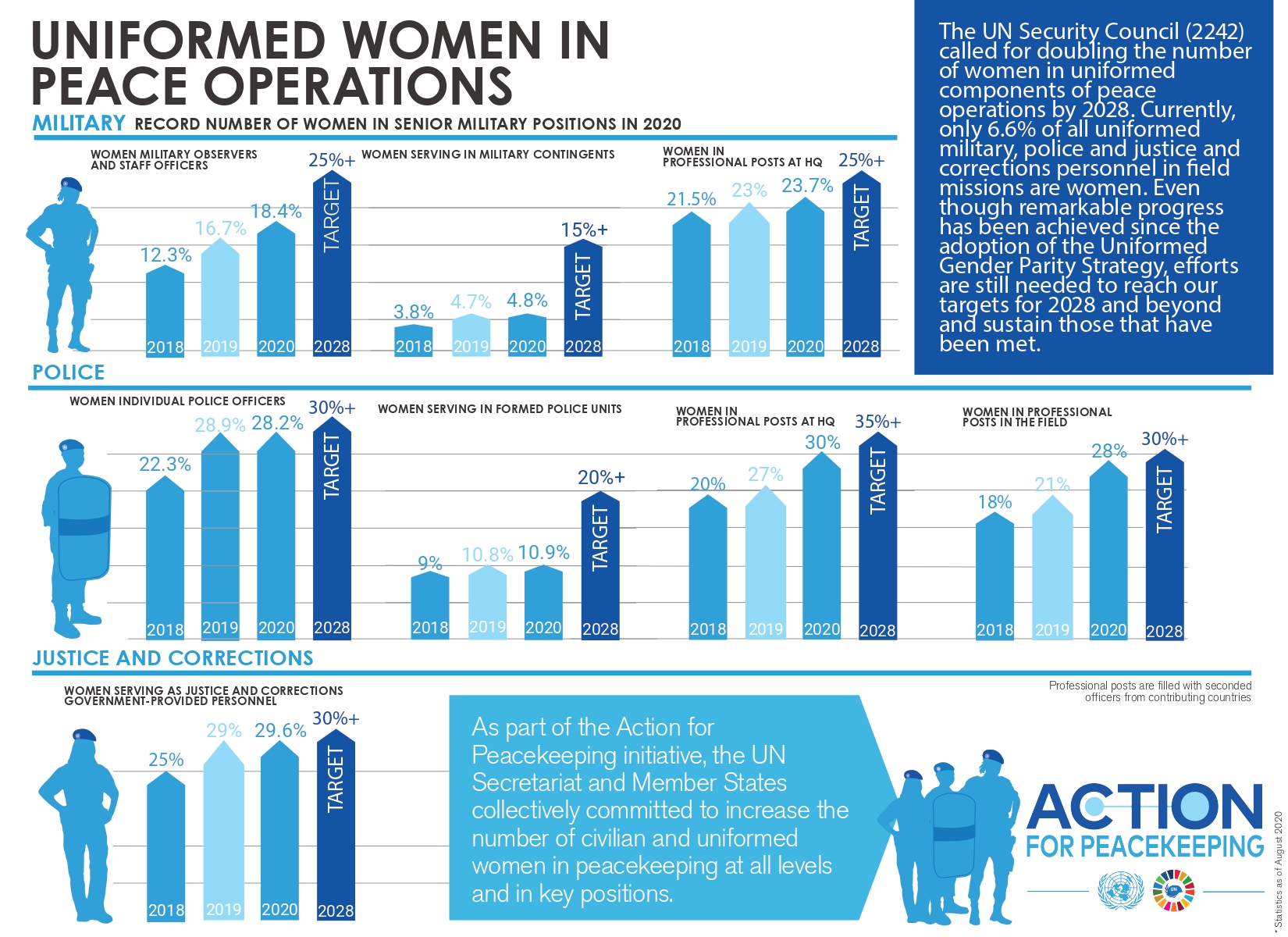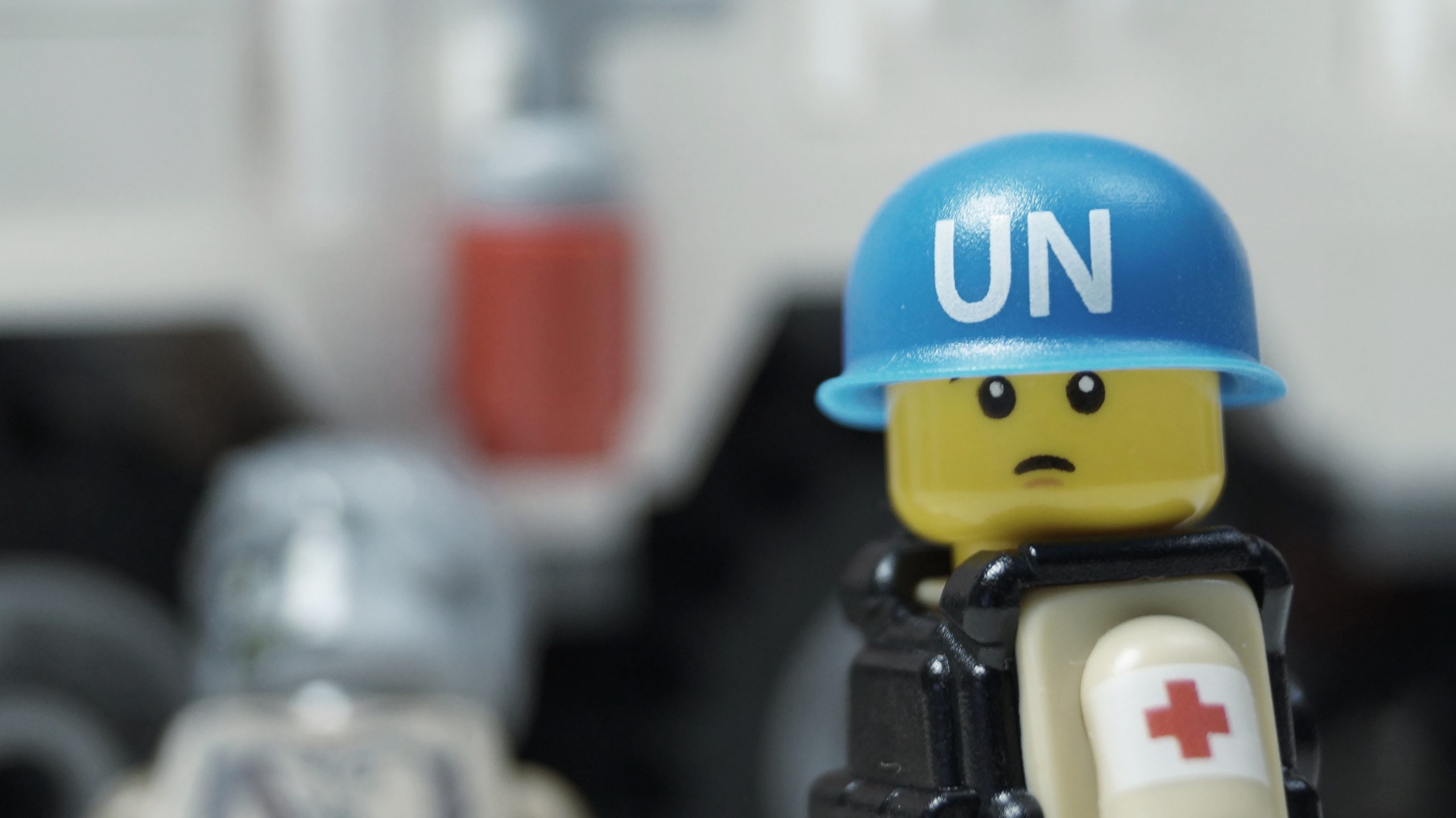In the past 72 years, 71 peacekeeping missions have been deployed by the United Nations. As of March 2022, the UN has 12 active operations, employing more than 90,000 military personnel from national armies around the world, UN police forces and civilian staff. The cost of the missions represents 0.5% of global military expenditure.
UN military personnel may be called upon for a series of mandates: protecting civilians and UN personnel, monitoring a disputed border, monitoring and observing peace processes in post-conflict areas, providing security in a conflict zone, providing security during elections, assisting military personnel in the country with training and support, or assisting ex-combatants in implementing peace agreements.
The 9,000 UN police officers from 94 countries, on the other hand, have patrolling, community support and national police duties.
On top of these, more than 14,000 civilians are involved in the missions. Civilian personnel perform many of the mandatory tasks of peacekeeping operations and also serve in the areas of finance, logistics, communications and technology, human resources and general mission administration.
A piece by Alice Pistolesi. Cover image: Flickr
Active missions in 2022
As of March 2022, 12 are the active peacekeeping operations. You can find them listed here:
- MINURSO, Western Sahara – The United Nations Mission for the Referendum in Western Sahara was established on 29 April 1991. It provided for a transitional period to prepare for a referendum in which the people of Western Sahara would choose between independence and integration with Morocco. The referendum has not yet taken place. 450 units are authorised for the mission. Bangladesh is the most represented country among the active military forces.
- MINUSCA, Central African Republic – The mission is mandated to protect civilians and support transition processes in the Central African Republic since 2014. Its other initial tasks included support for the transition process; facilitating humanitarian assistance; promotion and protection of human rights; support for justice and the rule of law; and disarmament, demobilisation, reintegration and repatriation processes. There are 15663 active forces.
- MINUSMA, Mali – Its mandate is to support the political process and help stabilise Mali. The Mission, established in 2013, was asked to support Mali’s transitional authorities in stabilising the country and implementing the transitional roadmap. Active: 18108 units. The most represented country is Chad.
- MONUSCO, Democratic Republic of Congo – The aim is to protect civilians and consolidate peace in the country. The new mission has been authorised to use all means necessary to carry out its mandate. Active: 17783 units. Pakistan is the most represented country.
- UNDOF, Golan Heights – The mission, established on 31 May 1974, was created to oversee the ceasefire and the agreed disengagement of Israeli and Syrian forces in the Golan Heights. 1205 forces are involved, with Nepal sending the most troops.
- UNFICYP, Cyprus – Its task is to contribute to a political solution in Cyprus. In the absence of a political solution to the Cyprus problem, UNFICYP remained on the island to supervise the ceasefire lines, maintain a buffer zone, undertake humanitarian activities. There are 1005 units engaged, with the UK the most represented military force.
- UNIFIL, Lebanon – The mission is tasked with monitoring the cessation of hostilities and helping to ensure humanitarian access to the civilian population. Following the July-August 2006 crisis, the Council upgraded the force and decided that, in addition to its original mandate, it would, inter alia, monitor the cessation of hostilities; accompany and support the Lebanese armed forces in their deployment throughout southern Lebanon; and extend its assistance to help ensure humanitarian access to the civilian population and the voluntary and safe return of displaced persons. 10683 units committed. Indonesia and Italy are the most represented countries.
- UNISFA, Abyei – Demilitarisation and peace monitoring in the disputed area of Abyei (Sudan) is its objective. The operation is tasked with monitoring the border between north and south and facilitating the delivery of humanitarian aid, and is authorised to use force to protect civilians and humanitarian workers in Abyei. UNISFA was established after the Government of Sudan and the Sudan People’s Liberation Movement (SPLM) reached an agreement in Addis Ababa, Ethiopia, to demilitarise Abyei and allow Ethiopian troops to monitor the area. There are 3801 forces involved, the largest contributor in terms of military personnel being Ethiopia.
- UNMIK, Kosovo – Established to promote security, stability and respect for human rights in Kosovo. Following the declaration of independence by the Kosovo authorities and the entry into force of a new constitution on 15 June 2008, the mission’s tasks were significantly modified to focus primarily on promoting security, stability and respect for human rights in Kosovo. 355 units are deployed. The main contributors are Russia and Germany for the police force and Austria, the Czech Republic, Germany, Russia, Turkey and Ukraine for the military side.
- UNMISS, South Sudan – Its objective is the protection of civilians, monitoring of human rights and support for the implementation of the Cessation of Hostilities Agreement. Following the crisis that erupted in South Sudan in December 2013, the Security Council, in its resolution 2155 (2014) of 27 May 2014, strengthened UNMISS and reprioritised its mandate towards the protection of civilians, human rights monitoring and support for the delivery of humanitarian assistance and for the implementation of the Cessation of Hostilities Agreement. 17982 forces engaged, with Rwanda the most active country in terms of military forces.
- UNMOGIP, India and Pakistan – The mission is responsible for observing the ceasefire in Jammu and Kashmir. The first group of UN military observers arrived in the mission area on 24 January 1949 to supervise the ceasefire between India and Pakistan in the state of Jammu and Kashmir. After the 1971 hostilities, UNMOGIP remained in the area to observe developments regarding the strict observance of the ceasefire. 111 forces were engaged, most of them Croats.
- UNTSO, Middle East – The mission aims to help bring stability to the Middle East. Established in May 1948, UNTSO was the first ever peacekeeping operation set up by the United Nations. Since then, UNTSO military observers have remained in the Middle East to monitor the ceasefire, oversee armistice agreements, prevent the escalation of isolated incidents and assist other UN peacekeeping operations in the region to fulfil their respective mandates. 388 forces committed. Finland the most represented.

Special Political Missions
In addition to peacekeeping missions, The UN counts some special political missions led by the UN Department of Political Affairs and Peacebuilding. In Africa, these missions can be found in the Great Lakes Region (covering Burundi, Rwanda, Uganda and the Democratic Republic of Congo), in Cameroon and Nigeria, in Central Africa with UNOCA, in the Horn of Africa, in Libya, in Mozambique, in Somalia, in Sudan, in West Africa and the Sahel and in Western Sahara with a special envoy. In America, they are in Colombia with the UN Verification Mission and in Haiti with BINUH.
Asia recounts a mission in Afghanistan, UNAMA, while in Central Asia there is UNRCCA and in Myanmar there is a special envoy. In Europe, missions are active in Cyprus with a special adviser, while in the Middle East they are in Iraq with UNAMI, in Lebanon UNSCOL, in Yemen UNMHA. In Syria and Yemen have also been sent special envoys.
Who does what: women in the missions
One of the UN Security Council’s goals is to double the number of women in uniform in peacekeeping missions by 2028. Currently only 6.6 per cent (31 December 2021: 5750) of uniformed personnel are women. Security Council resolution 1325 calls for equal participation of women in all areas of peacekeeping operations, including the military.
To promote women’s participation, the Women’s Military Peacekeepers Network was established in April 2015. So far, about a hundred female military peacekeepers have joined and are currently serving. It is an initiative of the Office of Military Affairs, which aims to unite military women who are currently serving or have served in United Nations peacekeeping operations. “The network,” it reads, “promotes, strengthens and enhances the profile of female military peacekeepers and creates a space for mutual support, mentoring, training and advocacy for female United Nations military personnel.
FOCUS 1: deaths on the missions
4173 are fatalities counted among peacekeepers from 1948 to 21 December 2021. The most fatal mission was UNIFIL in Lebanon with 324 casualties. In second place was UNAMID with 295 casualties (the African Union-United Nations hybrid mission in Darfur ended in 2020), and in third place was MINUSMA in Mali with 268 deaths, which recorded one of the highest mortality rates. 1993 was the most fatal year for peacekeeping, with 252 deaths. UN casualty monitoring includes UN staff, civilian staff, consultants, government-provided personnel, military personnel, government-provided civilian non-uniformed personnel, police personnel and individual contractors. The states contributing the most to peacekeeping missions with their own personnel are: Bangladesh with 6403, Nepal, India, Rwanda, Ethiopia, Pakistan, Egypt, Indonesia, Ghana and China. Among European states, Italy is the first with 1203 committed personnel.
FOCUS 2: a declaration of intent to strengthen the missions
In 2018, the UN Secretary-General worked on a Declaration of Shared Commitments to Strengthen Peacekeeping. As of January 2022, 155 countries have endorsed it. The goals of the document focus on eight priority areas of commitment: politics, women, peace and security, protection, safety and security, performance and accountability, peacebuilding and peace support, peacekeeping partnerships and conduct, and peacekeeping operations.
The necessity to reform the missions has been discussed for some time: in 2016, the United Nations had opened a debate among heads of state that produced more than 160 recommendations from member states. Many problems were identified: slow deployment, a heavy burden of bureaucracy and rising costs of operations.





















